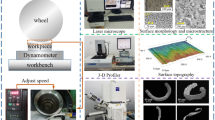Abstract
The paper analyses deformation and heat flow aspects of chip formation in grinding process by developed unique quick stop method and properties of ground surfaces, mainly micro-hardness. The cutting speed of the grinding process is within the range of high-speed turning and milling, so the chip formation is characterized by a high contact temperature and intensive plastic deformation. Moreover, the grinding wheel is a cutting tool of undefined geometry and the dimensions of grinding grains are several orders lower in comparison with the defined geometry cutting tools. The mentioned features make the research of the grinding process very specific. The paper provides the obtained micro-section of the chip forming process and the special chip shapes obtained by quick stop method in the grinding process. Furthermore, the paper analyses the special properties of the ground surface and even subsurface layers through the micro-hardness analysis, discusses performance in subsequent operating conditions and subsequent grinding of that layers. The experiments were carried out for the steel workpieces, ceramics grinding wheels and grinding without cooling.
Similar content being viewed by others
References
X. Huang et al., Experiment research on grind-hardening of AISI5140 steel based on thermal compensation, Journal of Mechanical Science and Technology, 30 (8) (2016) 3819–3827.
X. Huang et al., Experimental study on white layers in high-speed grinding of AISI52100 hardened steel, Journal of Mechanical Science and Technology, 29 (3) (2015) 1257–1263.
D. Fu et al., Simulation research on the grinding forces and stresses distribution in single-grain surface grinding of Ti-6Al-4V alloy when considering the actual cutting-depth variation, The International Journal of Advanced Manufacturing Technology (2017) 1–12.
S. Ji et al., Finite element analysis and simulation about microgrinding of SiC, Journal of Nanomaterials, 16 (1) (2015) 227.
L. Ma et al., Finite element simulation of grinding performance and grain shapes in grinding superalloy-inconel, Proc. International Symposium on Knowledge Acquisition and Modeling (KAM 2015) (2015) 199–201.
M. Rasim, P. Mattfeld and F. Klocke, Analysis of the grain shape influence on the chip formation in grinding, Journal of Materials Processing Technology, 226 (2015) 60–68
M. Kuffa, S. Züger, F. Kuster and K. Wegener, A kinematic process model and investigation of surface roughness for high efficiency dry grinding, Procedia CIRP, 46 (2016) 636–639
Y. Cao et al., Modeling and simulation of grinding surface topography considering wheel vibration, The International Journal of Advanced Manufacturing Technology, 66 (5–8) (2013) 937–945.
C. Cao and X. Zhang, Effect of different machining processes on the tool surface integrity and fatigue life, Journal of Mechanical Science and Technology, 30 (8) (2016) 3785–3792.
S. K. Khare and S. Agarwal, Predictive modeling of surface roughness in grinding, Procedia CIRP, 31 (2015) 375–380
H. N. Li and D. Axinte, Textured grinding wheels: A review, International Journal of Machine Tools and Manufacture, 109 (2016) 8–35
J. Buda and K. Vasilko, Patent of Slovak Republic No. 122243, Metóda zastavenia procesu obrábania bez špeciálnych prípravkov (Method for interruption of the machining process without special fixtures) (1972).
K. Vasilko and G. Bokucava, Brúsenie Kovových Materiálov (Grinding of Metal Materials) Bratislava, ALFA Bratislava (1988).
D. Setti et al., Performance evaluation of Ti-6Al-4V grinding using chip formation and coefficient of friction under the influence of nanofluids, International Journal of Machine Tools and Manufacture, 88 (2015) 237–248
Z. Murcinková and K. Vasilko, Thermo-physical aspects of chip machining, High Temperatures -High Pressures, 45 (4) (2016) 273–289.
M. Neslušan et al., Heat distribution when nickel alloy grinding, Tehnicki Vjesnik, 19 (4) (2012) 947–951.
Author information
Authors and Affiliations
Corresponding author
Additional information
Recommended by Associate Editor Wonkyun Lee
Karol Vasilko is a prominent academic person well-known throughout Central and Eastern Europe for his academic achievements and scientific contribution of manufacturing, cutting, chip forming and mechanical engineering. During 40 years of his professional career, he published over 300 research papers, 48 patents, 15 monographs and numerous student textbooks. In 1992, he founded a new university Faculty of Manufacturing Technologies with Seat in Prešov of Technical University of Košice. He has acted as an expert advisor to many national and international companies, while taught and mentored countless number of students from undergraduate to doctoral level.
Zuzana Murčinková focuses on the fields of mechanics of materials, of composite materials, applied mechanics, production machinery, manufacturing technologies, and static and dynamic simulation of mechanical behavior of structures using the finite element method. She is one of first graduates of a Faculty of Manufacturing Technologies.
Rights and permissions
About this article
Cite this article
Vasilko, K., Murčinková, Z. Experimental study of chip shapes in grinding by unique quick stop method and the ground subsurface layers micro-hardness. J Mech Sci Technol 33, 1341–1347 (2019). https://doi.org/10.1007/s12206-019-0234-0
Received:
Revised:
Accepted:
Published:
Issue Date:
DOI: https://doi.org/10.1007/s12206-019-0234-0




